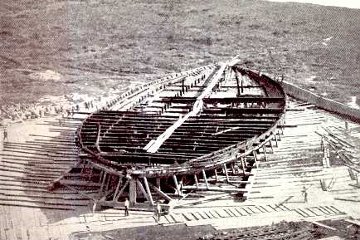Madman in Boots
Of all the mad and evil emperors that history inflicted on the Roman empire, Gaius Julius Caesar Augustus Germanics was arguably one of the worst - and yet it could all have been so different.
Gaius' father, Germanicus, was one of the most popular generals in Rome, genuinely successful in his campaigns (as opposed to other generals who covered up their apalling disasters with spurious claims of success), beloved by his troops and well-liked by the populace in Rome. It was Germanicus' misfortune to be living under the emperor Tiberius who grew insanely jealous of him, removed him from command and eventually - according to Suetonius - arranged for him to be poisoned in Antioch of Syria.
Before that, however, Germanicus took his family with him to Gaul, even allowing the young Gaius to accompany him on campaign against the Germans. Gaius became something of a soldiers' pet and someone produced a miniature Roman uniform for him, of which the three-year old boy became inordinately proud. He wore his tiny soldier's shoes, the caliga on every possible occasion and eventually the doting soldiers gave him the nickname of "Caligula" - "Little Boots".
After her husband's death, Caligula's mother, Agrippina (known as "the Elder" to distinguish her from the other Agrippinas in Roman history) was summoned back to Rome. She was the grand-daughter of Augustus and Tiberius feared that she might, through her husband, become a threat to him, so he refused to allow her to remarry. This not only bred deep resentment in Agrippina, but it left Caligula without a father figure from the age of 7 onwards.
In AD 29 further disaster struck the family when Caligula's brother, Nero, and his mother were both banished on charges of treason. The 17-year old Caligula was sent to live with his great-grandmother Livia and then with his grandmother Antonia. Neither was a particularly good influence on the growing boy and Robert Graves, in his excellently researched novel, I, Claudius, claims that Livia in particular tried to corrupt him for her own evil reasons.
The following year another brother, Drusus Caesar, was imprisoned on charges of treason and in AD 31 Caligula was ordered to join Tiberius on Capri. Probably Tiberius wanted to keep the boy under his eye, but it must have been a nerve-wracking experience to live with the constant fear of spies and of immediate death hanging over him.
Six years later Tiberius died and Tacitus claims that the Paretorian Prefect, Naevius Macro, who was an ally of Caligula, smothered the ailing emperor - though Suetonius says that it was Caligula himself who carried out the killing which he later blamed on Macro. Whatever the truth of the matter, the end of Tiberius' tyrannical reign was greated with joy in Rome and Caligula was hailed as a deliverer.
At first all went well: exiles were recalled, the secret denunciations for treason which Tiberius had kept were destroyed unread (though some later suspected that Caligula had kept them and actually burned blank sheets of papyrus), lavish games were held to satisfy the public, taxes were reformed and decreased, and various public works were undertaken.
Alas, those first few months also carried with them the portents of future evil. Caligula had his cousin, Tiberius Gemellus executed, along with his father-in-law and brother-in-law. His two sisters, Lavilla and Agrippina the Younger, were exiled, and Macro was forced to commit suicide - he knew too much! The only family member to survive these purges was Claudius, whose limp and stammer made him an object of ridicule to the young emperor, who delighted to mock and tease him.
Worst of all, Caligula behaved with reckless extravagance and Suetonius claims that in his first year alone he spent 2,700,000,000 sesterces which had been carefully built up by Augustus and Tiberius in the imperial treasury. The result was that after two years Caligula ran out of money and resorted to ingenious taxes - such as taxation of marriage and of prostitution - and to murdering rich people in order to seize their estates.

| |
| The hull of Caligula's floating palace, recovered from Lake Nemi in the 1930s and later destroyed by German shelling. |
Among his extravagances was the construction of two huge ships, one as a temple dedicated to the goddess Diana, the other as a floating palace, complete with marble and mosaic floors and all mod-cons, including central heating and running water. After Caligula's death these ships were deliberately sunk, but they were rediscovered by Italian archaeologists in the 1930s, who drained the lake in order to recover the ships. Unfortunately the restored ships were destroyed by German shelling on May 31, 1944.
By AD 40 Caligula was exhibiting signs of mental illness. Not only were treason trials started again, but Caligula led a vainglorious expedition to conquer Britain which got as far as the coast of France but then Caligula's nerve failed him and instead he ordered his soldiers to attack the sea and then to collect sea shells. He then returned to Rome to celebrate his triumph over Neptune - the shells were the "spoil of the sea"! Delusians of grandeur then led Caligula to declare himself a god and demand that the people worship him. It is reported that in pursuit of this claim, Caligula recalled his sisters and slept with them in imitation of some of the stories of the gods.
One of Caligula's closest friends - possibly because he was safely far away in Judea - was the Jewish king Agrippa. In AD 39 Agrippa was able to have Herod Antipas exiled by accusing him of treason. Herodias, the woman who had brought about the death of John the Baptist, went into exile with her husband despite being offered an amnesty because of her relationship to Agrippa, about the only good act in an otherwise depraved and wanton life.
When the Jews of Jamnia destroyed a clay altar erected for the worship of the emperor, Caligula retaliated by demanding that a statue of himself be erected in the temple of Jerusalem. It is greatly to the credit of the Roman governor, Publius Petronius, that he delayed carrying out this incendiary order for nearly a year. According to Josephus, Caligula finally lost patience and sent an order for Petronius to commit suicide, but fortunately the messenger was overtaken by a later messenger bearing news of Caligula's death!
Perhaps the most famous example of Caligula's insanity was his decision to make his favourite horse, Incitatus, a consul - the highset office of state. The horse was given golden shoes and a golden manger, waited on by senators and treated as you would expect a consul to be treated. It is not recorded what legislation was passed by Incitatus, but given the record of the later consuls, he was probably in improvement!
Caligula's insanity has been subject to different interpretations. Some suggest that it was the result of lead poisoning from Roman pipes and bowls; some claim that he suffered from hyperthyroidism; others attribute it to epilepsy while Philo and Juvenal attribute it to an illness in AD 39 and the medicines given to him at that time.
Most ancient sources believe that Caligula wasn't clinically insane but allowed arrogance and a lack of self-restraint to lead him down the path of cruelty and viciousness. That, I must admit, is the explanation I believe. A spoiled child, without the restraining influence of father or mother, urged into depravity by his guardians for their own selfish ends, and finally given unlimited and unrestrained power - it was a recipe for disaster. One cannot help but wonder what might have happened had Tiberius trusted Germanicus as he deserved. Calligula might still have ended up as emperor, but the honourable promise of his first two years might have been fulfilled.
As it was, in AD 41 officers in the Praetorian Guard, led by a man called Chaerea, conspired against Caligula and stabbed him to death as he walked through an underground passageway. After temporary burial, the body was cremated by Caligula's sisters and the ashes were placed in the Mausoleum of Augustus in the centre of Rome.

| |
| The town of Nemi, overlooking the crater lake of the same name. Italian carabinieri here arrested a man trying to smuggle a statue of Caligula out of the country. |
However in January 2011 Italian police in Nemi, the town overlooking the lake where Caligula's boats were found, arrested a local man as he was loading part of an 8' tall seated statue of a man dressed in a toga but wearing a pair of caligae. The statue had been broken in two in antiquity and had lost its head. When questioned, the man admitted that he was on his way to export the statue - in other words, to illegally smuggle it out of the country.
Specialists from the carabinieri examined the statue and noted that as well as the soldier's boots, the figure was dressed like a god, was seated on a throne, and was made of expensive Greek marble. Their conclusion was that it depicted Caligula. At that point the rubber hoses and burning matches came out and the smuggler was "persuaded" to confess all, which included taking the police to the place where he had found the statue.
Excavations are due to begin shortly, but speculation is already claiming that the police have discovered the tomb of Caligula. Well, it will be interesting to see what the archaeologists turn up, but I must admit that I have my doubts. The historical sources claim that Caligula's ashes were interred in his grandfather's mausoleum. If this discovery is indeed of Caligula, then it is more likely to be a shrine or small temple in his honour - and even more likely that the statue was erected in such a shrine and then quietly buried when the emperor fell from grace, thus preserving it while the shrine has long since disappeared.
sesterces The buying power of a sestertius varied, of course, but typical prices were two loaves of bread for a sestertius, a tunic for 15 sestertii, a donkey for 500 sestertii and, out in the provinces, a slave girl was 2,400 sestertii. The ordinary legionary was paid 900 sesterii a year (half being retained by the army for living expenses). Some have suggested that a sestertius was approximately equal to £1.20. Return
rediscovered In fact they had never been lost, as the Wikipedia article on the subject makes clear. Return
© Kendall K. Down 2011





